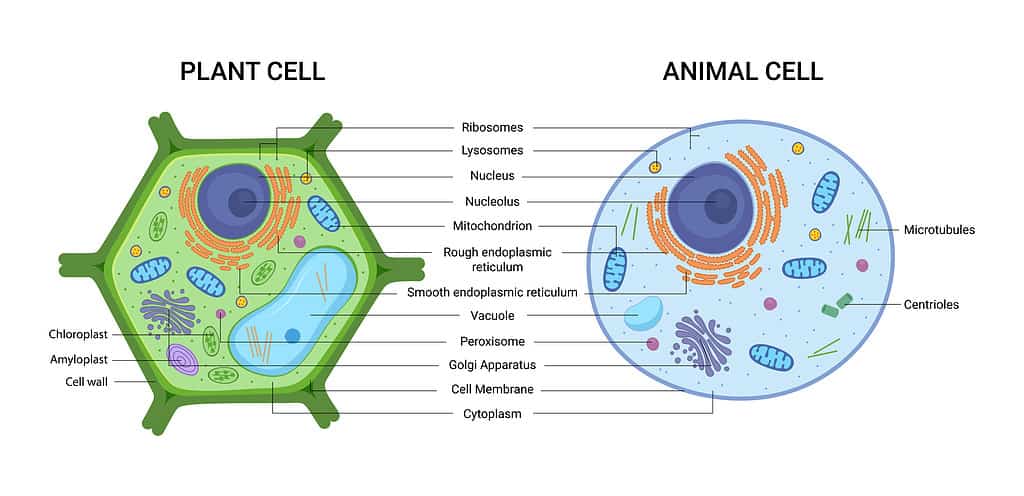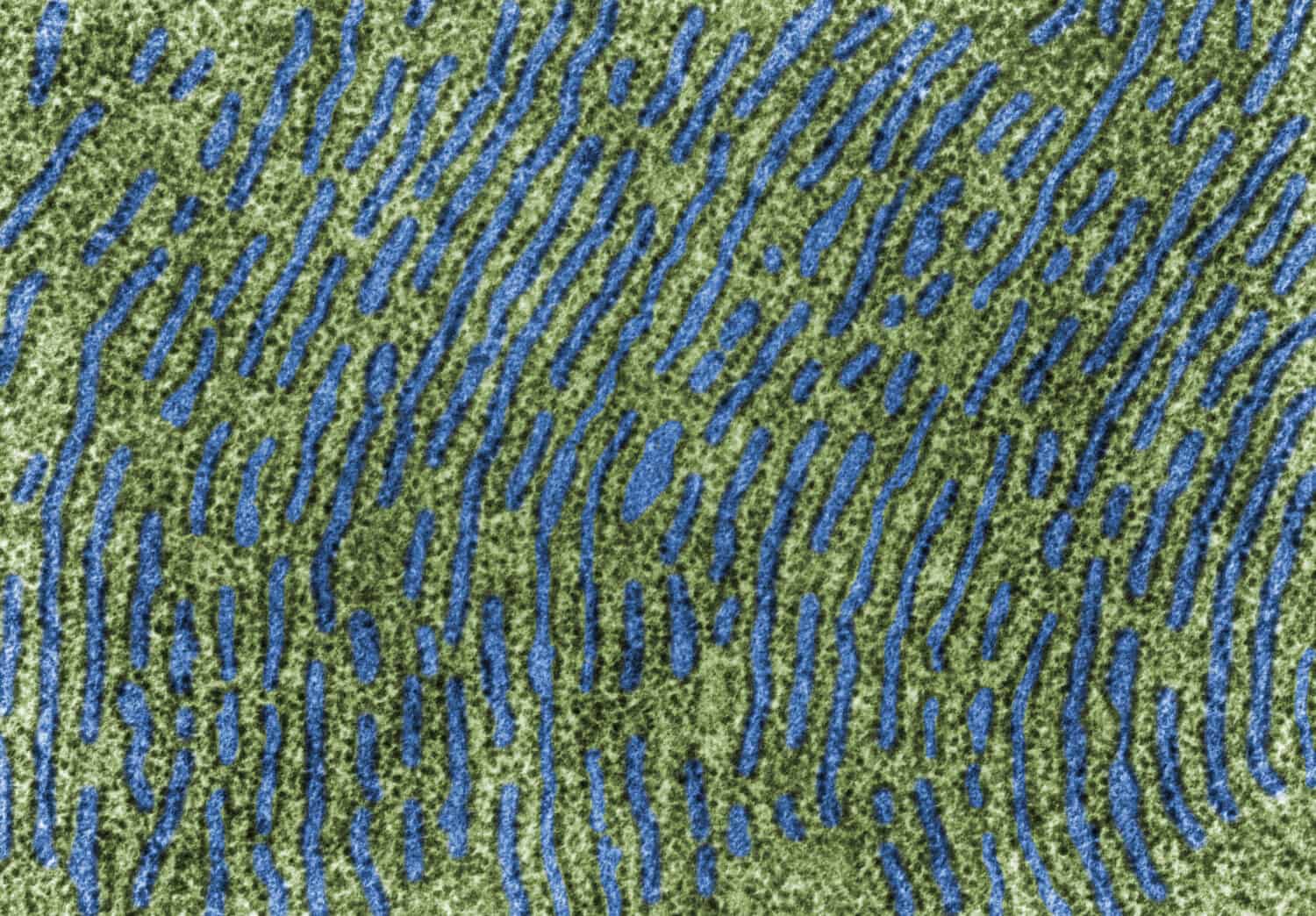In order to truly understand how every living thing on earth is able to live and thrive, you need to understand the complex nature of cells. Everything is made out of cells. The components of those cells are the cell organelles. Today, we are going to tell you everything you need to know about these molecular miracles, including the many specific organelles of a cell, diseases, and disorders related to organelles, and the research going on today that can help us to further understand these amazing building blocks of life.
What are Cell Organelles?

The cell organelles are parts inside of a cell, which you can see in the two examples above.
©iStock.com/Vitalii Dumma
Every species on the planet is made of cells, whether it’s a tiny single-celled organism or a multicellular organism. Cells are important because they provide structure and shape, and the cell organelles inside are involved in many cellular functions.
Cell organelles include both non-membrane and membrane organelles, which are present inside the cells, and they’re all specific in their functions and structures. Everything functions together within the cell. Some of the many unique functions that organelles perform include:
- Providing support and shape
- Creating the reproduction of a cell
- Building proteins
- Creating energy
- Destroying toxins
- Responding to external signals.
Essentially, organelles are like small rooms within a factory. In every room, there are specific jobs that are done so that the company as a whole can operate successfully. The organelles are located in the cytoplasm. That is a liquid found in the cell membrane that houses the organelles.
Structure and Function of Major Cell Organelles
There are various types of cell organelles that perform separate functions but operate as a whole in order to help humans, plants, and creatures live and thrive. These are the major cell organelles:
Cytoplasm
Present in both animal and plant cells, the cytoplasm is a jelly-like substance between the nucleus and the cell membrane, and it’s mostly water. The cytoplasm is one of the most important parts of the cell because it’s where all the organelles are embedded. This is also where enzymes are responsible for controlling metabolic activity in the cell and creating most of the chemical reactions.
Nucleus
The nucleus is very important. It’s a small subspace within the cell, but it is the largest of the organelles. The nucleus is partly responsible for making ribosomes, which are the molecules that are responsible for creating proteins. The nucleus also carries the chromosomes. The chromosomes are what carry your genes, which is what we inherit from our parents. Essentially, the nucleus controls the functions of the cells in our bodies. The nucleus also monitors our metabolism.
Mitochondria
In basic terms, the mitochondria provide the energy that our cells require to function, and it’s produced through a process known as cellular respiration. Technically, the mitochondria is a double membrane-bound organelle. The mitochondria are microscopic, but it includes many parts, including the cristae and inner and outer membranes. Energy is created here because of the sugars and fats that we have in our bodies. The mitochondria also regulate the metabolic activity of the cell, promote the growth of new cells, and it’s responsible for building certain parts of our blood, among other functions.
Endoplasmic Reticulum
Another of the cell organelles is the endoplasmic reticulum, which is a plasma membrane that’s inside the cell that folds on itself to create lumens. In addition to the lumens, the endoplasmic reticulum is also responsible for the production of metabolism, proteins, and the detoxification of poisons.
There are two types of endoplasmic reticulum: smooth and rough. The rough endoplasmic reticulum has an outer plasma membrane that’s carpeted with ribosomes, and protein production occurs there. The smooth endoplasmic reticulum lacks ribosomes, and it has many functions depending on the cell where it’s found. For instance, those in the liver would assist with detoxification functions.
Golgi Apparatus

Organelles of an animal cell showing different parts present in a cell including the Golgi apparatus.
©iStock.com/toonishwarhead
The Golgi apparatus or Golgi complex is a membrane-bound cell Golgi organelle that contains stacked pouches called cisternae. The primary function of this organelle is to modify, package, and transport proteins and lipids to their intended destinations. Essentially, this organelle is the mail room that ensures that everything goes where it’s needed. The Golgi apparatus is found within the cytoplasm of the cell. The Golgi complex regularly communicates with the many other organelles.
Lysosomes
The lysosomes are membranous sacs that carry out intracellular digestion. They are basically the cell’s recycling center. Lysosomes are important for many functions. Amoebas use lysosomes to digest food products. Lysosomes also recycle the cell’s own materials. Any damaged organelles are broken down in the lysosomes and are returned to the cell for reuse.
Peroxisomes
The main purpose of the spherical cell organelles called peroxisomes is to destroy their contents. Instead of recycling materials, the peroxisomes actually are responsible for the fatty acid breakdown. The peroxisomes also protect the cell from dangerous reactive oxygen species molecules. These dangerous molecules are made naturally but are made worse when we get radiation and use tobacco or drugs.
As a side note, the best way to prevent our peroxisomes from working overtime is to add antioxidants to our diet. Our peroxisomes are especially important in our liver because they attempt to remove the poisons from alcohol so we don’t become ill.
Plastids
The plastids are larger, membrane-bound organelles that contain pigments, including chloroplasts, chromoplasts, and leucoplasts, and they’re found in plants. Each of the pigments does different things. The chloroplasts help plants to trap light energy so they can go through photosynthesis. The chromoplasts provide plants with their color. Finally, the leucoplasts store proteins, oils, and fats for plants.
Ribosomes
The key role of ribosomes is to synthesize proteins as polypeptide chains to ensure the survival of the cell. They are tiny particles that are composed of a combination of RNA and protein.
Cytoskeleton
The main function of the cytoskeleton is to provide the shape of the cell and mechanical resistance to prevent deformation. The cytoskeleton is made up of different proteins that rapidly divide or reassemble in order to help the cells.
Vacuoles

Close-up image of the vacuoles in a plant.
©Jose Luis Calvo/Shutterstock.com
These are fluid-filled cell organelles that are enclosed by a membrane. Essentially, they are within bubbles in the cells. The point of vacuoles is to store the food and nutrients that a cell needs to survive. They also store waste products. The idea is that they protect the cell from contamination. Vacuoles are in animal and plant cells, but there are different numbers in each. Plants have larger vacuoles than animals.
Common Organelle-Related Diseases
Although cells contain the functional molecules of life, sometimes, cell organelles do not function as they should, and the result can be disease and other issues. Here are some of the diseases that could develop:
I-Cell Disease
Similar to Hurler syndrome, I-cell disease is a rare metabolic disorder that is characterized by skeletal abnormalities, coarse facial features, and sometimes mental retardation. It’s an inherited disease. This health issue has a connection to the lysosomes. Essentially, the illness is a result of one or more of your genes not working correctly. The symptoms are varied and can include anything from cardiovascular malformations and gum enlargement to delayed motor skills. There isn’t a cure, but patients can find support groups to make life easier.
Kartagener Syndrome
Kartagener syndrome is a form of ciliary dyskinesia, which can cause havoc in your body and even lead to reversed internal organs. In other words, your organs are on the opposite side of your body from where they should be. The problem is that your cilia aren’t working properly. Your cilia are the hair-like structures that rest on the surface of your cells. This condition is tied to your genes, which are made by your chromosomes. The switching of your organs can lead to heart conditions or issues in the lungs. In severe cases, a lung transplant surgery can be a potential treatment option.
Pompe Disease
Occurring anywhere from birth to late adulthood, Pompe disease is a rare and multisystemic illness that can lead to heart issues and skeletal weakness. If the disease happens earlier in life, it’s typically more severe. If a child has it in the first few months of birth, then life expectancy is typically less than two years. The cause of Pompe disease is due to the fact that your body cannot create the protein that breaks down complex sugar, and it damages the muscles and organs. Treatment can sometimes include enzyme replacement therapy, but there is no real cure.
Treacher-Collins Syndrome
This is a rare genetic disorder featuring distinctive and obvious abnormalities in the head and face. Usually, the characteristics include an underdeveloped jaw, cheekbones, and mouth, which can make breathing difficult. Other symptoms include eyelids with a downward slant, a cleft palate, and small lower jaws. Typically, this condition is passed down from parents, and it involves issues associated with prenatal gene mutations. Care would need to be provided by a genetics specialist.
MELAS Syndrome
The technical term is Mitochondrial encephalomyopathy, Lactic Acidosis, and Stroke-like episodes (MELAS). This is a mitochondrial disease that affects the muscles and nervous system. The disease literally affects the mitochondria in our cells. The mitochondria turn our food into energy so that our cells function normally. Because this syndrome disrupts the process, we get these issues in the immune system. There are many symptoms, including the possibility of stroke and numbness of the body that can be fatal. MELAS is rare, only affecting up to 16 people out of 100,000.
Current Research Related to Cell Organelles
Scientists and medical experts are always researching cells and cell organelles because the breakthroughs they find can help to cure the diseases mentioned above and help with other issues that we’ve yet to face.
For instance, one such study conducted at Umea University involves finding a new organelle that’s located inside the neurons that we use to perceive smell. They’ve given this new organelle the name multivesicular transducosome and it can help scientists to learn about odors, and the nerve impulses in the brain.
Meanwhile, at Goethe University Frankfurt, researchers have actually created artificial cell organelles that can help them to learn more about biochemical reactions. By controlling the human-made cells, they hope to understand more about what makes us tick and also help to find remedies to common diseases.
Conclusion
We tend not to think about our cells or our cell organelles, but when they are so essential to our existence, it’s important to stay in the loop. If you’d like to learn more, a search online will provide thousands of resources, so fill your thirst for knowledge. If you believe you have a genetic disease and you want support, reach out to your doctor for answers.
Thank you for reading! Have some feedback for us? Contact the AZ Animals editorial team.








